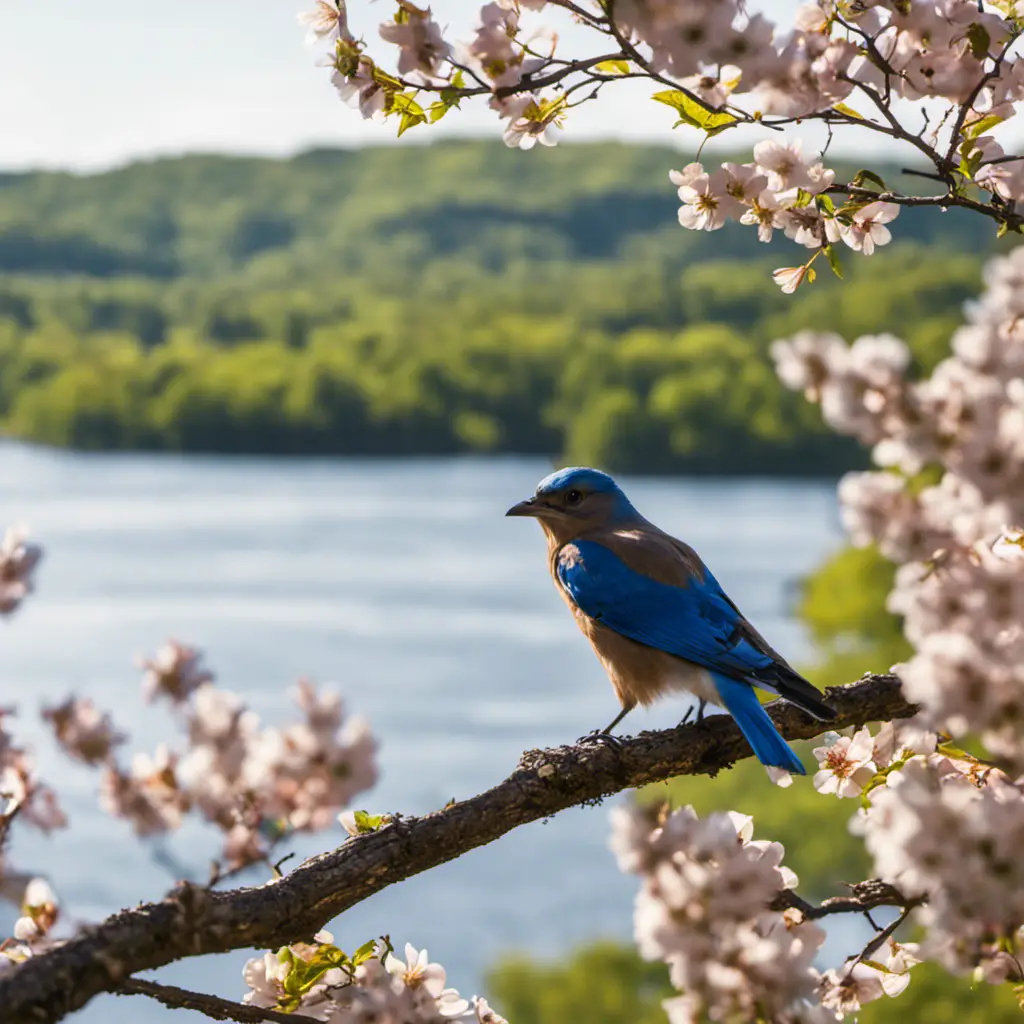We’ll go through the most common birds you’re likely to encounter in Vermont, as well as their pictures and important information. Only reputable sources were used, and the data were double-checked with an ornithologist.
Did you know that Vermont is home to more than 200 different bird species? From the common blue jay to the elusive ivory-billed woodpecker, there’s something for everyone when it comes to Vermont birds.
In this blog post, we will take a closer look at some of the most common birds found in the Green Mountain State. Whether you’re a bird enthusiast or just looking to learn more about your local wildlife, this post is for you!
10 Common Birds in Vermont:
- Blue Jay
- American Crow
- Black-capped Chickadee
- Tufted Titmouse
- White-breasted Nuthatch
- Northern Cardinal
- American Goldfinch
- House Finch
- Mourning Dove
- Downy Woodpecker
State bird of Vermont: Hermit Thrush
The hermit thrush is the state bird of Vermont and can be found in wooded areas throughout the state. This small songbird has a gray-brown back and wings, with a rust-colored tail. The breast and belly are white, with dark spots on the sides.
How many birds are recorded in Vermont:
There are over 200 bird species that have been recorded in Vermont. This number is constantly changing, as new birds are discovered and others move out of the state.
The biggest bird in Vermont:
The biggest bird in Vermont is the American bald eagle, which can weigh up to 14 pounds and have a wingspan of up to seven feet. These impressive birds are common along the state’s waterways, where they feed on fish and other prey.
The smallest bird in Vermont:
The smallest bird in Vermont is the ruby-crowned kinglet, which weighs just half an ounce and is only four inches long. These tiny birds are found in wooded areas across the state and are known for their high-pitched song.
Vermont National parks where you can find birds:
There are several national parks in Vermont where you can see birds, including the Green Mountain National Forest, Marsh-Billings-Rockefeller National Historical Park, and Silvio O. Conte National Fish and Wildlife Refuge.
Blue Jay
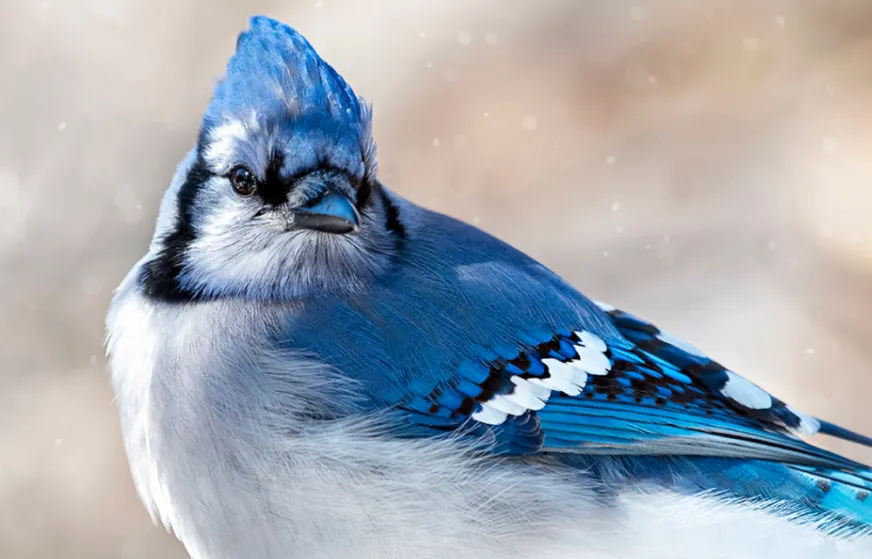
The Blue Jay is a member of the crow family. It is about the same size as a robin and has a wingspan of about 12 inches. The back and wings are blue, the head is white with a black “mask” around the eyes, and the underparts are pale gray.
The tail is long and pointed. Jays are very active and noisy birds. They are often seen perched on tree limbs, where they hop around and search for food.
Jays eat a variety of things, including insects, nuts, berries, and seeds. They also like to steal food from other animals. Blue Jays live in wooded areas near open fields or meadows. They build their nests in trees, usually near the top. Blue Jays are common in most of North America.
The blue jay is a member of the crow family and is about 12 inches in length with a wingspan of about 20 inches. The back and wings are typically blue while the head is white with a black “mask” around its eyes.
The blue jay typically has a long and pointed tail. They are known to be very active and noisy birds often seen perched on tree limbs where they will hop around looking for food.
Jays are known to eat a variety of things including insects, nuts, berries, and seeds. However, they have also been known to steal food from other animals.
They typically live in wooded areas near open fields or meadows and build their nests in trees, usually near the top. Blue jays are common in most of North America.
While blue jays typically live in wooded areas, they have been known to adapt to other habitats such as urban areas. In recent years, there has been an increase in the blue jay population. However, despite their commonality, blue jays are still considered to be medium-sized birds.

American Crow
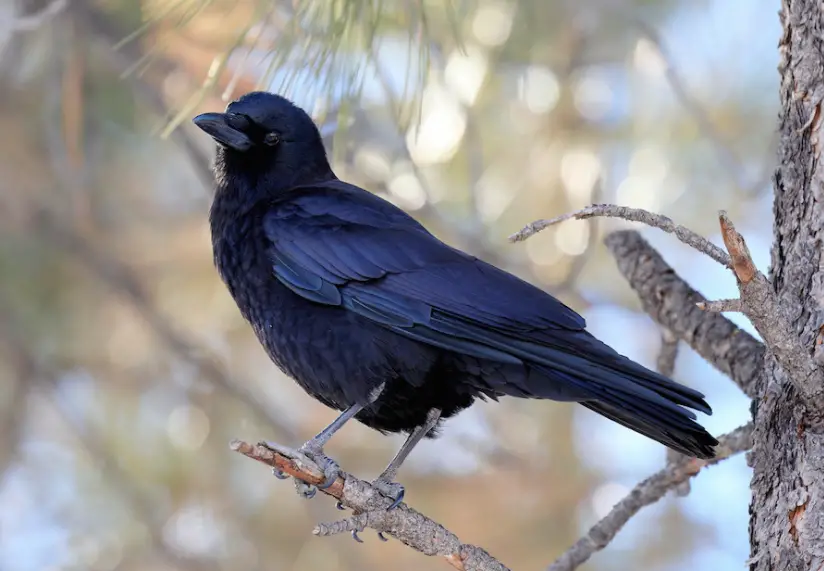
The American Crow is a large black bird that can be found in Vermont. They have a characteristic cawing call and are often seen perched on telephone wires or scavenging for food on the ground. Crows are very intelligent birds and can be trained to do simple tasks.
They are omnivorous and eat a variety of foods, including insects, small animals, seeds, and fruits. Crows live in a variety of habitats, including forests, fields, and urban areas. They are often seen in pairs or groups.
American Crows are not migratory birds.
Crows are interesting creatures and have been the subject of many myths and legends. These birds are very beneficial to humans as they help control insect and rodent populations.
Crows are considered to be pests by some people because they can be noisy and destructive. However, they are an important part of the ecosystem and play a vital role in the food chain. American Crows are protected by law in some states and it is illegal to kill them.

Black-capped Chickadee
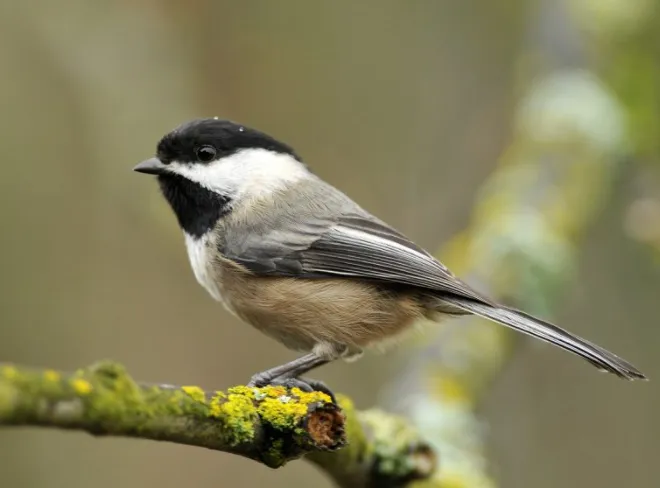
The Black-capped Chickadee is a small, sprightly bird with a black cap and bib set off by a white face. They are acrobatic foragers, often hanging upside down as they search tree bark for food. Chickadees are not shy around people and will often approach close enough to take food from their hands.
They are common in deciduous and mixed forests, as well as residential areas, and eat a variety of foods including insects, seeds, and berries. In winter they often feed at birdfeeders. These cheerful birds can be found throughout Vermont year-round.
Black-capped Chickadees are about five inches long with a wingspan of about eight inches. They have a black cap and bib with white cheeks. The back and sides are grayish brown, and the underparts are whitish with light gray shading.
Chickadees have a short tail that is often held upright. Males and females look alike, but juveniles lack the black cap.
Chickadees are very active birds and are always busy foraging for food. They are known for their acrobatic abilities, often hanging upside down as they search tree bark for insects.
Chickadees are also quite curious and will often approach people closely to take food from their hands. They are common in deciduous and mixed forests, as well as residential areas.
Chickadees eat a variety of foods including insects, seeds, and berries. In winter they often feed at birdfeeders. These cheerful birds can be found throughout Vermont year-round. So if you’re ever in the Green Mountain State, keep your eyes peeled for these little acrobats.

Tufted Titmouse
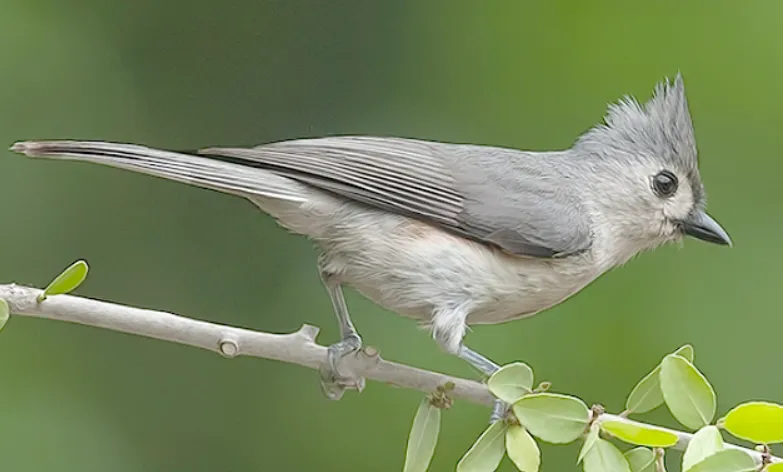
Tufted Titmice are small, sparrow-sized songbirds that have a characteristic crest of feathers on their heads. They are gray or brown with rusty flanks and white bellies.
Tufted Titmice are common in deciduous forests and woodlands, but can also be found in parks and gardens. These birds are very active and are constantly in motion, hopping from branch to branch in search of food.
Tufted Titmice eat a variety of insects and other small invertebrates, as well as seeds and berries. In the winter months, they will often form small flocks with other titmice and chickadees to feed on the buds and seeds of trees.
Tufted Titmice are very vocal birds, and can often be heard singing their cheerful “tit-i-lee” song from high in the trees. They are a common sight in Vermont during the winter months.

White-breasted Nuthatch
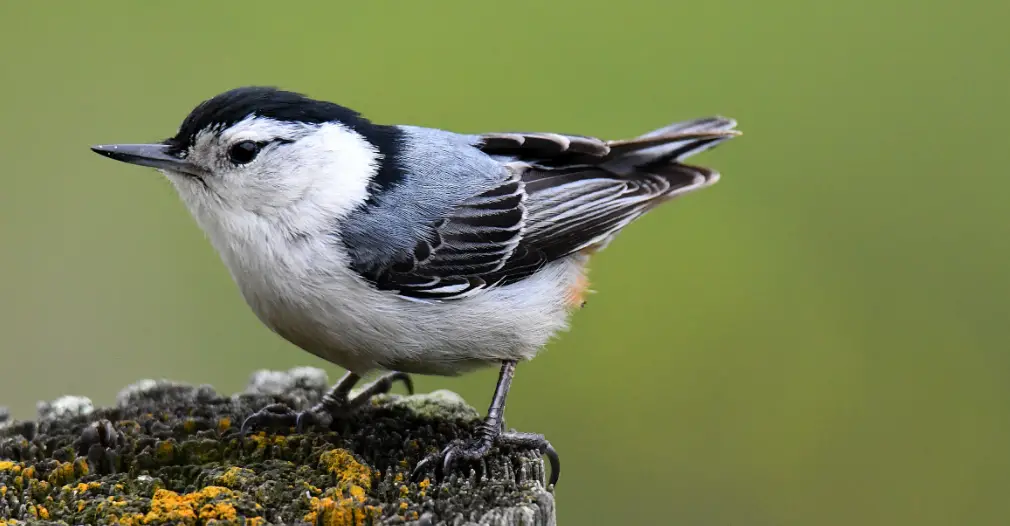
The White-breasted Nuthatch is a small, stocky bird that has a blue-gray back, white breast, and black cap. They have a long tail and strong legs that allow them to climb headfirst down trees.
These birds are usually about six inches in length and weigh about an ounce.
They are the only North American nuthatch that regularly climbs down trees. Most other nuthatches only move up and down tree trunks.
The White-breasted Nuthatch has a sharp bill that is curved slightly downwards. This adaptation allows the bird to pry open bark to find insects to eat.
White-breasted Nuthatches are found in forests across North America. They are most common in the eastern United States but can also be found in the west, as far north as Alaska and as south as Mexico. These birds are year-round residents and do not migrate.
White-breasted Nuthatches usually mate for life and will often stay together during the winter months. The male and female will build a nest together in a tree cavity. The typical clutch size is four to six eggs.
White-breasted Nuthatches are omnivores and eat a variety of insects, seeds, and nuts. They can be found foraging for food on the ground, in trees, or even on power lines. These birds are known to store food in tree crevices for later use.

Northern Cardinal
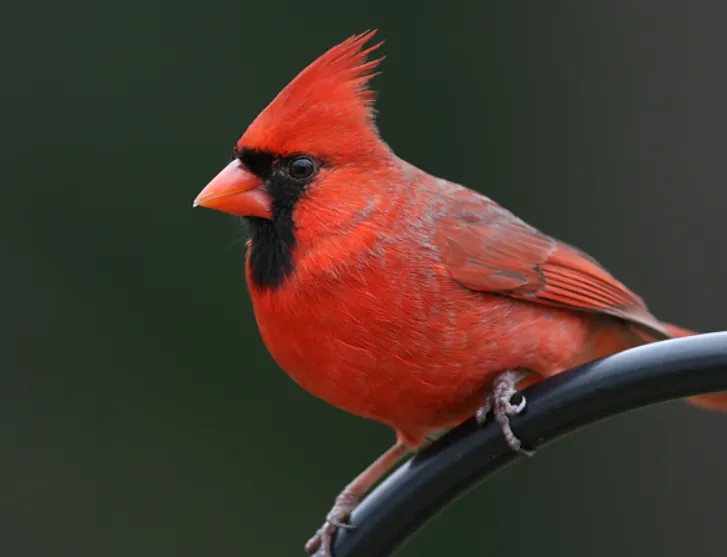
The Northern Cardinal is one of the most recognizable birds in North America. They are about the size of a sparrow, with a reddish-brown body, black head and throat, and bright red bill.
Cardinals are very active birds, hopping around on the ground or perching high in trees to search for food. They eat mostly seeds and insects, but can also eat fruit and berries.
Cardinals are commonly found in open woodlands and yards across the eastern United States. In Vermont, they can be found in forested areas, parks, and gardens.
They are a popular bird to watch because of their bright colors and cheerful song. Cardinals are year-round residents in Vermont, so you can enjoy their beauty any time of year!
If you would like to attract cardinals to your yard, you can do so by providing a few simple things. Cardinals prefer habitats with dense vegetation for nesting and cover from predators.
They also need a source of water for drinking and bathing. You can provide these things by planting dense shrubs and trees, putting out a birdbath, and leaving some fallen branches or logs for them to perch on.

American Goldfinch
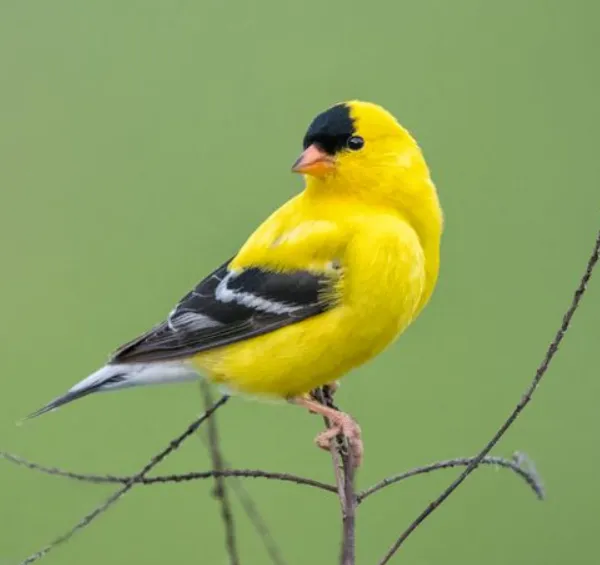
The American Goldfinch is a small, stocky bird with a short tail and round head. They have bright yellow plumage in the summer and olive-colored feathers in the winter. Males are slightly brighter than females.
These birds are very active and can be seen hopping around on the ground or darting through the trees. They eat a variety of seeds but prefer thistle and sunflower seeds. American Goldfinches can be found in open fields, parks, and gardens throughout Vermont.
American Goldfinches are about the size of a sparrow. They have a wingspan of about six inches and weigh between 0.25 and 0.35 ounces.
These birds are covered in bright yellow feathers year-round, with olive-colored feathers on their heads and backs in the winter. Male American Goldfinches are slightly brighter than females.
American Goldfinches are very active birds. They can often be seen hopping around on the ground or darting through the trees. When they are not feeding, these birds spend a lot of time preening their feathers.
American Goldfinches eat a variety of seeds, but they prefer thistle and sunflower seeds.
They can be found in open fields, parks, and gardens throughout Vermont.
American Goldfinches are a common sight in Vermont. These birds can be found in open fields, parks, and gardens throughout the state. They are very active and can often be seen hopping around or darting through the trees.

House Finch
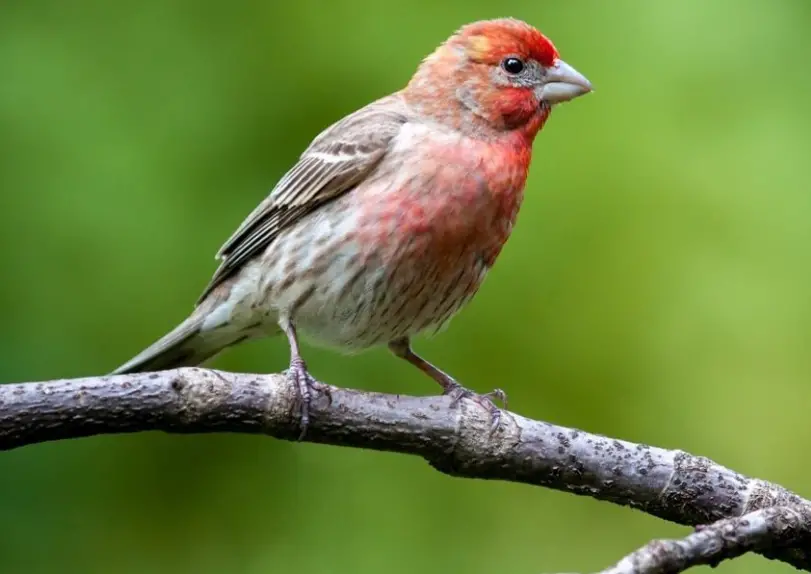
The house finch is a small bird with red feathers. The male has a bright red head and breast while the female is more drab-colored. These birds are often seen perching on telephone wires or feeding at bird feeders. They eat a variety of seeds and will also visit flower beds in search of insects.
House finches build nests out of twigs and line them with soft materials such as feathers. The female lays three to six eggs which hatch after about two weeks. Both parents help care for the young birds.
After about four weeks, the chicks are ready to leave the nest. House finches are common in most parts of the United States.
House Finch Characteristics:
- Small bird with red feathers
- Male has a bright red head and breast, female is more drab-colored
- Often seen perching on telephone wires or feeding at bird feeders
- Eats a variety of seeds
- Nests out of twigs, lined with soft materials
- Lays three to six eggs
- Both parents help care for young birds
- After four weeks, chicks are ready to leave the nest.
House Finch Size:
The house finch is about the size of a sparrow. The male is slightly larger than the female.
House Finch Appearance:
- Small, stocky bird with a short tail and round head
- Bright yellow plumage in the summer, olive-colored feathers in the winter
- Males are slightly brighter than females
House Finch Behavior:
These birds are very active and can be seen hopping around on the ground or darting through the trees. They also spend a lot of time preening their feathers.
House Finch Habitat:
House finches can be found in open fields, parks, and gardens throughout the United States.
House Finch Diet:
These birds eat a variety of seeds but prefer thistle and sunflower seeds. They will also visit flower beds to feed on insects.

Mourning Dove
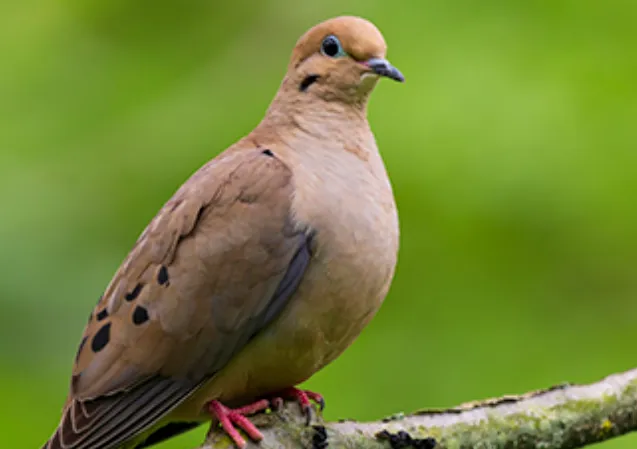
The Mourning Dove is a small, stocky bird with a short tail and round head. They have bright yellow plumage in the summer and olive-colored feathers in the winter. Males are slightly brighter than females.
These birds are very active and can be seen hopping around on the ground or darting through the trees. They also spend a lot of time preening their feathers.
Mourning Doves eat a variety of seeds but prefer thistle and sunflower seeds. They can be found in open fields, parks, and gardens throughout Vermont.
The Mourning Dove is a common sight in Vermont. These birds can be found in open fields, parks, and gardens throughout the state. They are very active and can often be seen hopping around or darting through the trees.
Mourning Dove Size:
The Mourning Dove is about the size of a sparrow.
Mourning Dove Appearance:
Small, stocky bird with a short tail and round head
Bright yellow plumage in the summer, olive-colored feathers in the winter
Males are slightly brighter than females
Mourning Dove Behavior:
These birds are very active and can be seen hopping around on the ground or darting through the trees. They also spend a lot of time preening their feathers.
Mourning Dove Habitat:
Mourning Doves can be found in open fields, parks, and gardens throughout the United States.
Mourning Dove Diet:
These birds eat a variety of seeds but prefer thistle and sunflower seeds. They can be found in open fields, parks, and gardens throughout Vermont.
The Mourning Dove is a common sight in Vermont. These birds can be found in open fields, parks, and gardens throughout the state. They are very active and can often be seen hopping around or darting through the trees. After about four weeks, the chicks are ready to leave the nest.

Related post: Most Common Backyard Birds of Nebraska
Downy Woodpecker
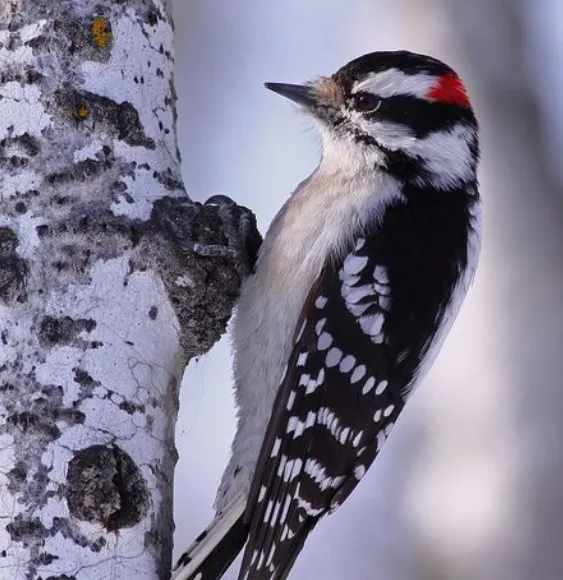
The Downy Woodpecker is the smallest woodpecker in North America. They are about six inches long and have a wingspan of about 11 inches. They weigh between two and three ounces. Downy Woodpeckers have black and white feathers, with a red patch on their head.
They have a short, sharp beak, which they use to peck at trees in order to find insects. Downy Woodpeckers live in forests, parks, and yards. They eat insects, such as ants, beetles, and caterpillars. Downy Woodpeckers can be seen year-round in Vermont.
Both parents help care for young birds. After four weeks, chicks are ready to leave the nest.
House Finch Size:
The house finch is about the size of a sparrow. The male is slightly larger than the female.
House Finch Appearance:
Small, stocky bird with a short tail and round head
Bright yellow plumage in the summer, olive-colored feathers in the winter
Males are slightly brighter than females
House Finch Behavior:
These birds are very active and can be seen hopping around on the ground or darting through the trees. They also spend a lot of time preening their feathers.
House Finch Habitat:
House finches can be found in open fields, parks, and gardens throughout the United States.
House Finch Diet:
These birds eat a variety of seeds but prefer thistle and sunflower seeds. They will also visit flower beds to feed on insects.
The house finch is a common sight in Vermont.

Ruby-throated Hummingbird
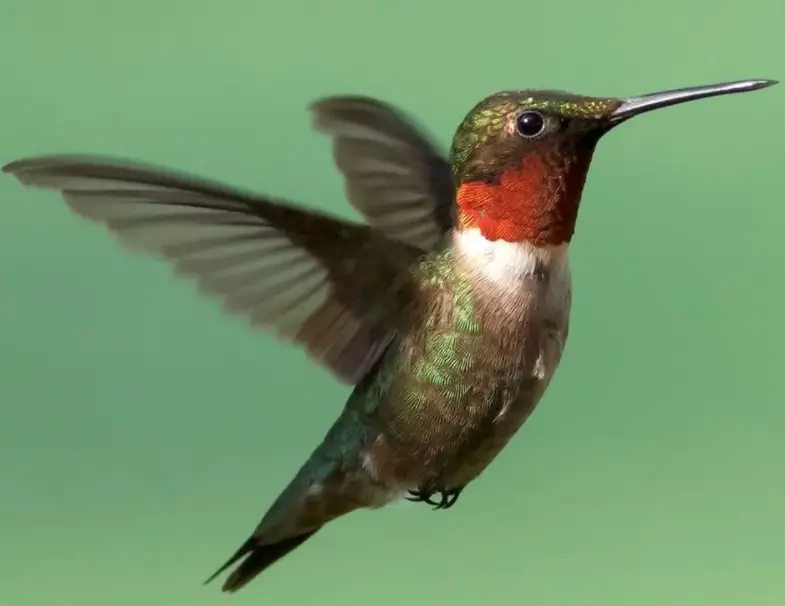
The Ruby-throated Hummingbird is a small bird that is native to North America. They are about three inches long and have a wingspan of four inches. They weigh between two and six grams.
These birds are mostly green with a white chest and belly. The male has a red throat, while the female does not.
Ruby-throated Hummingbirds feed on nectar from flowers. They also eat small insects, such as mosquitoes and aphids. These birds live in forests, meadows, and gardens. In Vermont, they can be seen from late April to early October.
The Ruby-throated Hummingbird is the only species of hummingbird that breeds in the eastern United States.
Both parents help care for young birds. After four weeks, chicks are ready to leave the nest.
The Ruby-throated Hummingbird is a common sight in Vermont. These small birds can be found in forests, meadows, and gardens throughout the state. They feed on nectar from flowers as well as small insects.
The males have a bright red throat, while the females do not. These birds can be seen from late April to early October. After four weeks, chicks are ready to leave the nest.

Cedar Waxwing
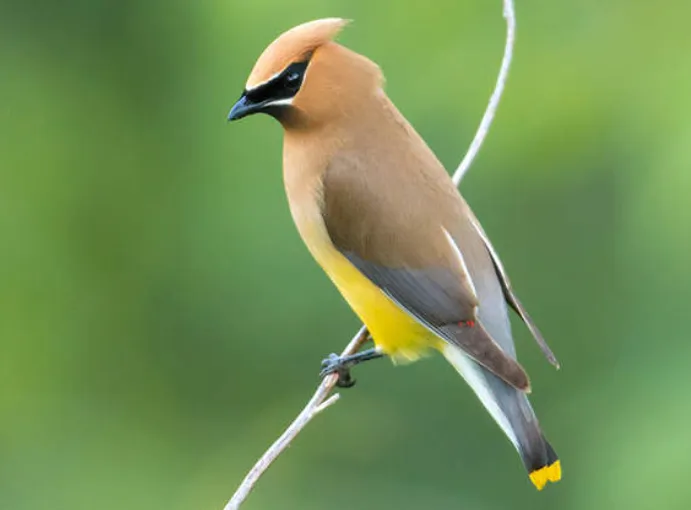
The Cedar Waxwing is about the size of a sparrow, with a wingspan of about eight inches. They have a brown back and head, with creamy-colored feathers on their underside and around their face. Their eyes are black, and they have a small yellow crest on their head. Cedar Waxwings eat mostly fruit, but will also eat insects and other small animals. They live in open areas such as fields, parks, and gardens. Cedar Waxwings are common in Vermont during the summer months.
The behavior of Cedar Waxwing
Their behavior is very social, and they often flock together in large groups. They are known for their playful antics and can be seen chasing each other and playing games with each other. Cedar Waxwings are very vocal and can be heard singing their distinctive song throughout the summer. They are also known for their appetite and can be seen gobbling up fruit in short order.
Habitat of Cedar Waxwing
The Cedar Waxwing’s habitat is typically open areas such as fields, parks, and gardens. In Vermont, they are common in the summer months.
Diet of Cedar Waxwing
The Cedar Waxwing’s diet consists mostly of fruit, but they will also eat insects and other small animals. They have a very hearty appetite and can be seen gobbling up fruit in short order.

Common Yellowthroat
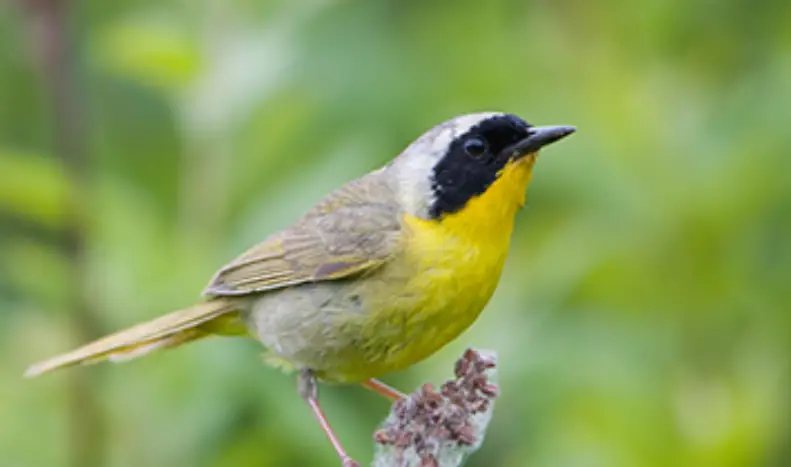
The Common Yellowthroat is a small bird that is native to North America. They are about four inches long and have a wingspan of six inches. They weigh between eight and twelve grams.
These birds are yellow with black stripes on their head and back. The males have a bright yellow throat, while the females do not.
Common Yellowthroats feed on insects. They live in forests, meadows, and gardens. In Vermont, they can be seen from late April to early October.
The Common Yellowthroat is a common sight in Vermont. These small birds can be found in forests, meadows, and gardens throughout the state. They feed on insects.
The males have a bright yellow throat, while the females do not. These birds can be seen from late April to early October. After four weeks, chicks are ready to leave the nest.

Dark-eyed Junco
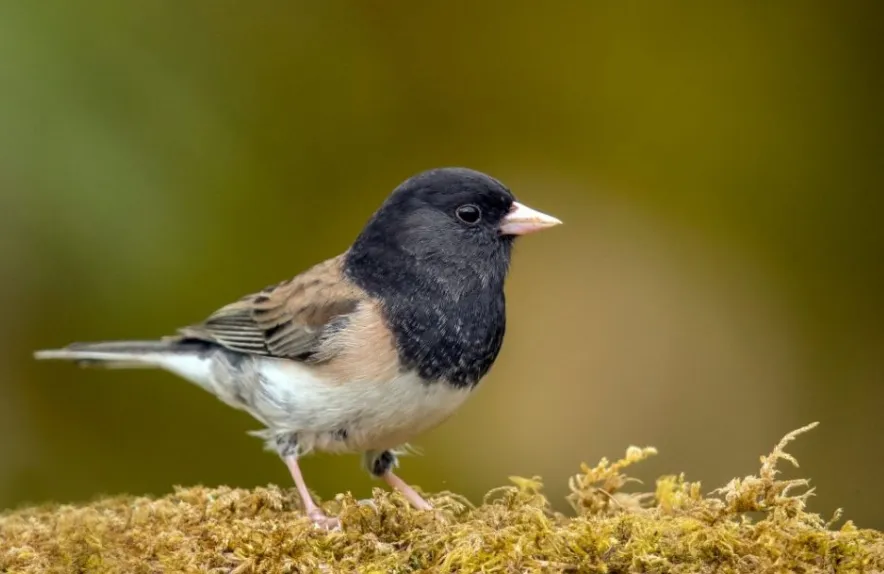
The Dark-eyed Junco is a small sparrow that is commonly found in Vermont.
One of the best times to see Dark-eyed Juncos in Vermont is during the winter months. They can be found in open areas such as forests, fields, and even urban areas. During the summer, they can be found in lower elevations, but they will move to higher elevations during the winter.
Appearance of Dark-eyed Junco
The Dark-eyed Junco has a black cap and white underparts. They are usually about six inches in length, with a wingspan of eight to ten inches. The males have a gray back and tail, while the females have a brown back and tail.
Behavior of Dark-eyed Junco
Dark-eyed Juncos are very active birds, and they are known for their quick movements and playful behavior. They typically inhabit open areas such as forests and fields, but they can also be found in urban areas. Their diet consists mostly of insects and seeds. In the winter, they often eat berries and fruits.
Habitat of Dark-eyed Junco
The Dark-eyed Junco is a small sparrow that is commonly found in Vermont. They have a characteristic black cap and white underparts, and they are usually about six inches in length. Dark-eyed Juncos are very active birds, and they are known for their quick movements and playful behavior. They typically inhabit open areas such as forests and fields, but they can also be found in urban areas. Their diet consists mostly of insects and seeds. In the winter, they often eat berries and fruits. After four weeks, chicks are ready to leave the nest.
Diet of Dark-eyed Junco
The Dark-eyed Junco’s diet consists mostly of insects and other small animals. They have a very hearty appetite and can be seen gobbling up fruit in short order.
Dark-eyed Juncos are common sights in Vermont all year round. These small birds can be found in forests, meadows, and gardens throughout the state. They feed on insects and seeds, but during the winter they will also eat berries and fruits. The males have a bright yellow throat, while the females do not. These birds can be seen from late April to early October. After four weeks, chicks are ready to leave the nest.

Eastern Phoebe
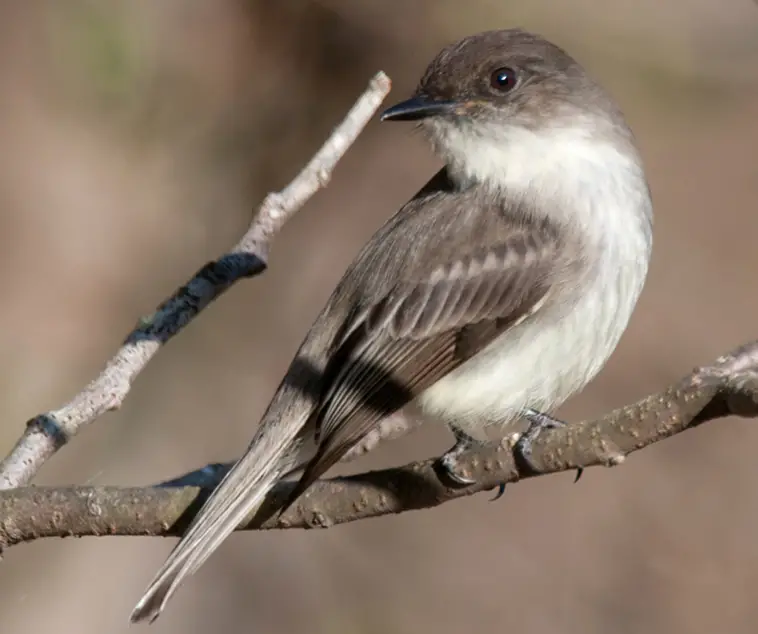
The Eastern Phoebe is a small, stocky bird that is usually around six inches in length. They have a dark head and upper body, with a light-colored chest and belly.
The Eastern Phoebes are common sights along the edges of streams and rivers, where they feed on insects. They are also known to forage in open fields and meadows.
The Eastern Phoebe is a very vocal bird, and can often be heard singing its distinctive “phe-be” song from high up in a tree or on a wire. They are generally tame birds, and will often allow people to get quite close before flying away.
Eastern Phoebes typically nest in cavities, either in natural hollows or in man-made structures such as birdhouses. They will often reuse the same nest site for many years.
The diet of the Eastern Phoebe consists mainly of insects, which they capture by swooping down on them from a perch. They will also eat some berries and seeds.
The Eastern Phoebe is a common bird in Vermont, and can be found in a variety of habitats including forests, meadows, and along the edges of streams and rivers. They are generally shy birds, but can often be seen perched on a wire or high up in a tree singing their distinctive song.
They feed mainly on insects, which they capture by swooping down on them from a perch. Eastern Phoebes typically nest in cavities, either in natural hollows or in man-made structures such as birdhouses.

Gray Catbird
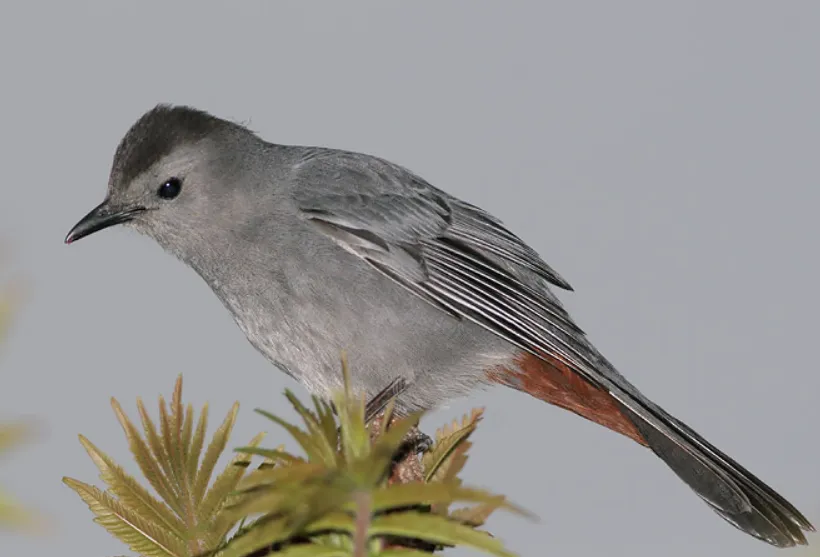
The Gray Catbird is a small, gray songbird that is found in Vermont. They are usually about eight inches in length, with a wingspan of twelve inches. The males have a black cap and tail, while the females have a brown cap and tail.
Gray Catbirds are very vocal birds, and can often be heard singing their distinctive “mew” song from high up in a tree. They are generally shy birds, but will often allow people to get quite close before flying away.
The diet of the Gray Catbird consists mainly of insects, which they capture by swooping down on them from a perch. They will also eat some berries and seeds.
Gray Catbirds are common in Vermont and can be found in a variety of habitats including forests, meadows, and urban areas. After four weeks, chicks are ready to leave the nest.

Hairy Woodpecker
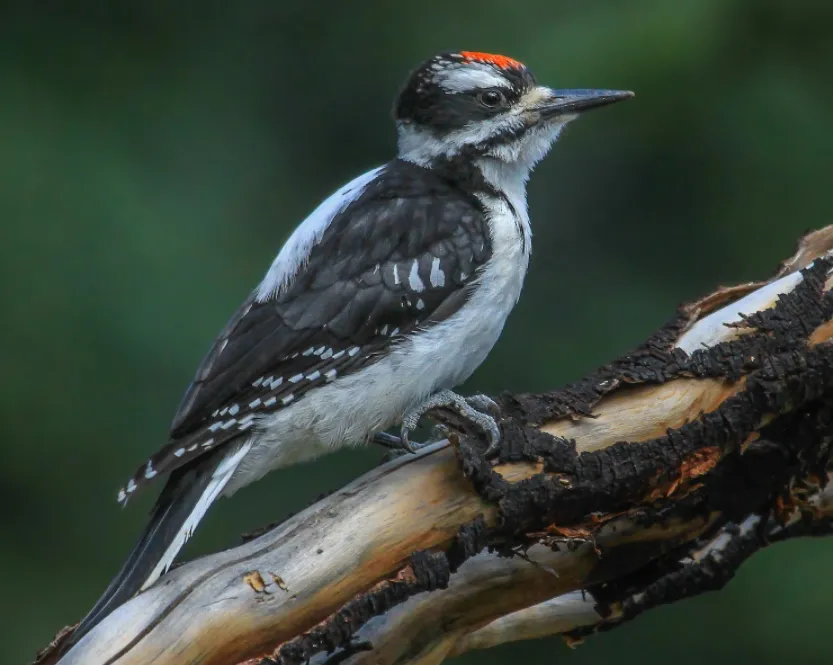
The Hairy Woodpecker is the largest woodpecker in Vermont. It has a black back, wings, and tail, and a white head and underparts.
The male has a red cap on his head. These birds measure about 11 inches long and have a wingspan of 17 inches. They weigh between three and five ounces.
Hairy Woodpeckers are usually solitary, but they may form small flocks in winter. They forage on the ground or in trees, eating insects and larvae. They also eat berries and seeds.
These birds nest in a hole in a tree, often using an old woodpecker hole. The female lays four to six eggs, and the male incubates them for about two weeks. The young birds stay with their parents for several months.
Hairy Woodpeckers are common in Vermont and can be found in a variety of habitats, including forests, woodlots, orchards, and parks. They are usually seen near the ground, where they forage for insects. These birds are useful in controlling insect populations.
They are also interesting to watch, and their drumming on trees is a familiar sound in Vermont forests. Hairy Woodpeckers are a common sight in the state and make great additions to any birding list.

American Robin
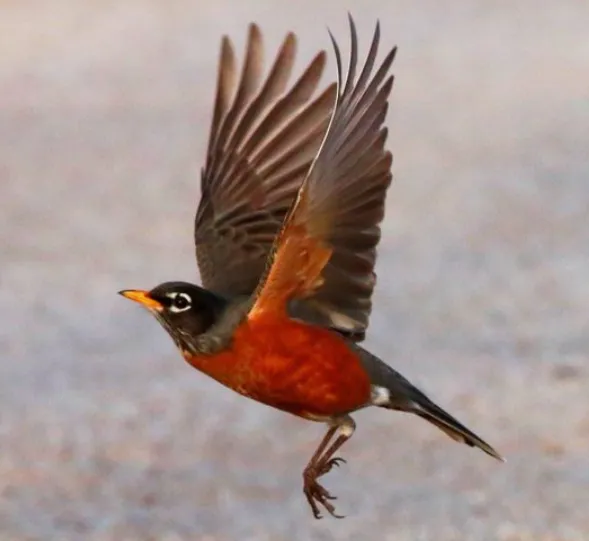
write about characteristics of American Robin, size of American Robin, the appearance of American Robin, the behavior of American Robin, habitat of American Robin, and diet of American Robin in Vermont.
The American robin is a migratory songbird of the true thrush genus and Turdidae, the wider thrush family. The sexes are similar in plumage, but young birds have browner upper parts. It is one of the most familiar birds in eastern North America.
It breeds in open woodlands, gardens, parks, and on farms across southern Canada to central Alaska, as well as throughout the eastern and mid-western United States.
Robins are commonly seen perched on street lights or utility wires waiting for dawn to sing their characteristic song consisting of several discrete units. The robin is a popular bird in both North American and British gardens and was introduced to New Zealand and Australia where it has also become widely established.
The American robin is about 20 cm (23-25 in) long, with an average wingspan of 32 cm (13 in). The adult has dark gray-brown upperparts, paler underparts, and a dark brown tail with a paler base.
The throat and breast are brick red in color, while the belly is white. There is also an orange-red band on the face between the bill and eyes.
Males and females have similar plumage, but young birds are browner overall, have buffy underparts, and lack the orange-red band on their faces.

Mourning Doves

Mourning doves are one of the most common types of birds in North America. They have a characteristic cooing call and are often seen perched on wires or fences. Mourning doves are about 12 inches long, with a wingspan of about 20 inches.
They are pale brown with black spots on their wings and have long tails. Mourning doves are ground-dwellers and eat seeds and insects. They can be found in open areas such as fields and meadows, as well as in suburban and urban areas.
Mourning doves are monogamous, meaning they have one mate at a time. The male dove courts the female by singing to her and bringing her food.
The two doves build a nest together, and the female lays two eggs. Both parents care for the young birds until they are old enough to leave the nest.
Mourning doves are hunted for sport in many states, including Vermont. The hunting season for mourning doves runs from September to November.
During this time, hunters are allowed to kill up to 15 birds per day. Mourning doves are also hunted for their meat, which is considered a delicacy in some cultures.

Song Sparrow
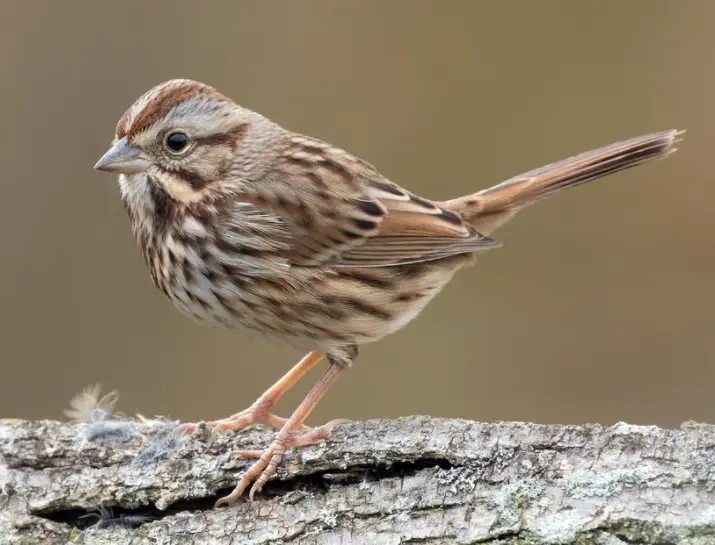
The Song Sparrow is a small, sparrow-like bird that can be found in Vermont. They have characteristic markings on their heads and chests and are usually a pale brown or gray color. Song Sparrows are very active birds and are known for their cheerful song.
They live in open areas near water, such as marshes, fields, and gardens. Song Sparrows eat a variety of things, including insects, seeds, and berries. They are considered to be common birds in Vermont.
Size: about six inches
Appearance: small, sparrow-like bird with characteristic markings on head and chest
Behavior: very active; known for their cheerful song
Habitat: open areas near water, such as marshes, fields, and gardens
Diet: insects, seeds, berries

Other birds you might see from your backyard in Vermont:
House Finch, American Goldfinch, Dark-eyed Junco, Northern Cardinal, Cedar Waxwing, Purple finch. all of which are migratory songbirds. House Sparrows, which are not native to North America but have been introduced here and now thrive in many urban areas.
Rock Pigeons and European Starlings, both of which are introduced species that have become very common in North America.
Wood Ducks, Wild Turkeys, Ruffed Grouse, and American Black Bears, all of which are native to Vermont but not commonly seen in suburban or urban areas. Bald Eagles and Ospreys, both of which are raptors (birds of prey) that can occasionally be seen in Vermont.
Peregrine Falcons, are rare but have been known to nest in Vermont. Snowy Owls, are very rare but have been seen in Vermont on occasion.
Small Birds in Vermont
There are many small birds that can be found in Vermont. Some of these include the Song Sparrow, House Finch, American Goldfinch, Dark-eyed Junco, Northern Cardinal, Cedar Waxwing, and Purple finch.
All of these birds are migratory songbirds. This means that they travel to different parts of the country during the different seasons.
Most Common Vermont’s Fall and Winter Birds
As the weather gets colder, some birds migrate south for the winter. Others stay in Vermont and can be seen throughout the fall and winter months.
The most common birds that you might see in your backyard during this time are the Dark-eyed Junco, Northern Cardinal, Cedar Waxwing, and Purple Finch.
How to attract feeder birds of Vermont:
There are many ways to attract feeder birds in Vermont. One way is to provide a variety of food for them to eat. This can include seeds, fruit, and insects.
Another way is to offer them a place to nest and shelter from the cold weather. A good way to do this is by putting up a birdhouse or bird feeder.
You can also attract birds by providing them with water. This can be in the form of a birdbath or a small pond.
Black oil sunflower seeds:
This type of seed is a favorite among many birds, including chickadees, nuthatches, and woodpeckers.
Nyjer seeds: Also known as thistle seeds, these are favored by finches and siskins.
Peanuts: Peanuts are a good source of protein for birds and are especially loved by blue jays, cardinals, and mockingbirds.
Suet: Suet is a type of fat that is high in protein and can be fed to birds year-round. It is favored by woodpeckers, chickadees, titmice, and nuthatches.
Are pelicans in Vermont?
Pelicans are not native to Vermont, but they have been known to travel through the state on occasion. They are most likely to be seen in the spring and fall months.
If you see a pelican in Vermont, it is probably just passing through on its way to somewhere else.
How many species of birds are in Vermont?
There are over 200 different species of birds that can be found in Vermont. Some of the most common ones include the Song Sparrow, Dark-eyed Junco, Northern Cardinal, Cedar Waxwing, and American Goldfinch.
All of these birds can be seen in suburban or urban areas, but there are also many other types of birds that can only be found in more rural parts of the state.

An avid ornithologist, zoologist and biologist with an unwavering passion for birds and wild animals.
Dr. Wilson’s journey in ornithology began in childhood and led him to obtain a Ph.D. in Ornithology from the prestigious Avian Research Institute. He has worked closely with renowned experts in the field and conducted extensive research and field studies globally.


